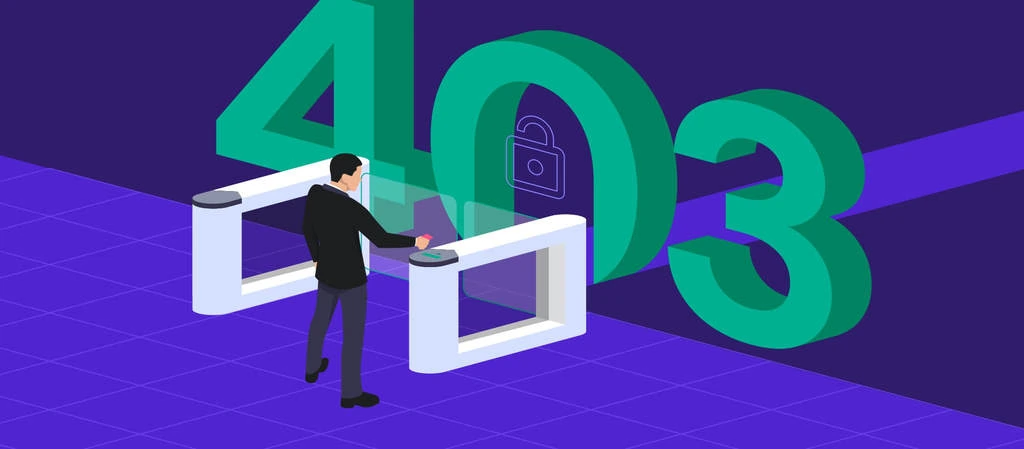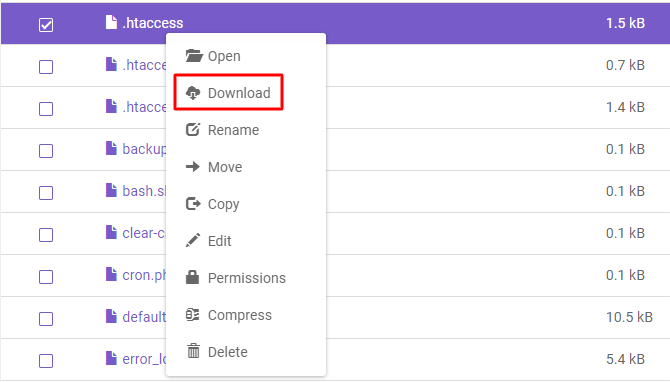// We Alredy Got an Error Trying to Access Dir So Dont Try to Access It Again
Mar fifteen, 2022
Domantas K.
8min Read
What Is the 403 Forbidden Fault & How to Fix Information technology (8 Methods Explained)

Kickoff A Complimentary seven-day Email Course On WordPress
Yous might meet the 403 forbidden error when you visit an empty website directory or a specific folio that has a permission fault. This is because most websites are set up to disallow directory browsing to forbid attackers from accessing sensitive files.
However, if you or your visitors encounter this error on your site, it'southward necessary to fix the result or you may risk losing valuable traffic. Since its causes vary, there are many methods to resolve the 403 errors.
We will explain the dissimilar types of 403 forbidden errors, their possible causes, and also provide eight methods to fix the 403 forbidden error.
| Error code | 403 Forbidden Mistake |
| Error type | Client-side error |
| Fault variations | Forbidden: You don't have permission to access [directory] on this server HTTP Error 403 – Forbidden Fault 403 – Forbidden 403 forbidden request forbidden past authoritative rules 403 Forbidden Admission Denied – You don't have permission to access Error 403 HTTP 403 Forbidden |
| Error causes | Missing index folio Broken WordPress plugin Wrong IP address Malware infection New web page link |
What Is a 403 Forbidden Error?
403 Forbidden – you lot don't accept permission to access this resource is an HTTP status code that occurs when the web server understands the asking merely tin't provide additional admission.
Video Tutorial
Too busy to read? Here is our video tutorial.

Subscribe For more educational videos! Hostinger Academy
Causes of 403 Forbidden
Oftentimes, HTTP 403 forbidden errors are caused by an access misconfiguration on the client-side, which means you can normally resolve the outcome yourself.
A mutual cause of these errors is the file or folder permission settings, which control who can read, write, and execute the file or binder.
There are two possibilities in this example: either the website owner edited the settings so that y'all couldn't admission the resources, or they didn't gear up the correct permissions.
The second common cause is corrupt or incorrect settings in the .htaccess file. This might happen afterwards you've made changes to the file. Luckily, it's easy to solve the issue by simply creating a new server configuration file.
Other than those two common causes, here are another possible triggers for the error:
- Missing index page – the website'due south homepage name is non alphabetize.html or alphabetize.php.
- Faulty WordPress plugin – if a WordPress plugin is non configured correctly or is incompatible with some other plugin, information technology may trigger the 403 errors.
- Wrong IP address – the domain proper noun points to a wrong or quondam IP address which now hosts a website that blocks your admission.
- Malware infection – a malware infection may cause the .htaccess file to be constantly corrupted. Y'all'll need to remove the malware before restoring the file.
New web page link – the site owner may take updated the page's link, which is at present different from the buried version.
How to Ready the 403 Forbidden Fault
Since the HTTP 403 forbidden error is closely related to file access permissions, this will be the main focus of the following methods to solve it. That said, there are other ways of resolving this issue, such every bit immigration the browser enshroud or scanning for malware.

Let's take a better wait at each of the eight available methods to solve the HTTP error 403.
Please notation that while the steps mentioned here mainly focus on WordPress, they can be practical to other websites as well.
one. Check the .htaccess File
You may not be familiar with the .htaccess file, as information technology oft remains hidden in the site directory. All the same, if you use Hostinger File Manager, the file is available in your public_html directory by default.
Follow these steps to locate it:
- Find the File Manager on the hPanel dashboard.

- Open the public_html directory to find the .htaccess file.

If you utilize cPanel, follow these steps:
- Locate File Director on cPanel.

- In the public_html directory, look for the .htaccess file.

- If y'all can't detect the file, click on Settings on the top-right corner of the screen and enable the Testify Subconscious Files (dotfiles) choice.

The .htaccess file is a server configuration file and mainly works by altering the Apache Spider web Server settings.
Although the file is nowadays on most websites by default, y'all need to create a new file manually if your website doesn't have information technology or if information technology was deleted unintentionally.
Now that you accept found the file, follow these steps to check whether a wrong configuration is causing the error:
- Right-click on the file and select Download to create a backup.

- Once you have the backup, delete the file.

- Try accessing your website. If it works fine, this indicates that the file was corrupted.
- To generate a fresh .htaccess file, log in to your WordPress dashboard and click on Settings -> Permalinks.
- Without making whatever changes, click the Save Changes push at the bottom of the page.

This will generate a fresh .htaccess file for your website. If this didn't solve the effect, try the side by side method.
2. Reset File and Directory Permissions
Another possible cause triggering HTTP 403 errors is incorrect permissions for files or folders. In general, when files are created, they come with specific default file permissions, which control how yous tin can read, write, and execute them.
Pro Tip
If yous're using Hostinger, in that location'due south a special tool that volition take intendance of all your permission problems in simply a single click. Enter Ready File Ownership in the search bar or scroll to the bottom of your control console to Other and locate information technology there.

This tool volition save you lot loads of time and will restore all file and directory permissions to default values.
Using FTP will let you edit file and binder permissions. To begin, you should:
- Configure an FTP client and connect it to your website.
- Once continued, right-click public_html and select File Attributes.

- Enter permission 755 in the Numeric value field, select Apply to directories only, and press OK.
The general do for file permission numeric values is using 755 for folders, 644 for static content, and 700 for dynamic content.

- After changing folder permissions, repeat step 2 and step iii, but now enter 644 in the Numeric value field and select the Apply to files merely option.

In one case washed, try accessing your website and run into if the error is resolved.
three. Disable WordPress Plugins
If you have come this far and none of the previous methods work, chances are that the mistake is caused past an incompatible or faulty plugin. In this stride, we will try disabling plugins to cheque whether doing then fixes the 403 forbidden error.
We recommend disabling all the plugins at once instead of going through the process one past one. Following this method, you should be able to detect the problem and work towards a solution. Here is what you'll take to do:
- Access your hosting business relationship via FTP or apply the hosting account's file director and go to the public_html -> wp-content folder.
- Locate the plugins folder.

- Rename the folder with a unlike name like "disabled-plugins" to disable all plugins.

Endeavour reaccessing the website. If the error is no longer there, a problematic plugin is the actual source of the error.
Rename the folder dorsum to plugins. Now you take to disable the plugins one by 1 from your WordPress dashboard and cheque if the site is still working. This mode, you will be able to find the faulty plugin.
Once you find it, update the plugin if necessary or delete it. However, if the mistake still appears, you lot may need to contact your hosting provider for assistance.
four. Upload an Alphabetize Folio
Cheque your website's homepage proper noun – information technology should exist called alphabetize.html or index.php. If it's not, and so in that location are two alternatives. The first and simplest one is to rename the homepage as alphabetize.html or alphabetize.php.
However, if you want to proceed the current homepage name, upload an index page to your public_html directory and create a redirect to your existing homepage.
Here are the steps to follow:
- Upload an alphabetize.html or index.php file to your public_html directory. Use your hosting account'south file manager or FTP to do so.
- Open the .htaccess file.
- Insert this code snippet to redirect the index.php or index.html file to your existing homepage. Don't forget to replace
homepage.htmlwith the folio's actual proper name.
Redirect /alphabetize.html /homepage.html
v. Edit File Ownership
Incorrect file ownership can trigger the 403 forbidden fault if you utilise Linux or VPS web hosting.
Typically, files and folders tin be assigned to an Possessor, a Grouping, or both. Keep in mind that yous need SSH access to modify ownership in these environments. You'll likewise need an SSH concluding to connect to the VPS.
Once you lot've connected SSH to your website server, cheque the ownership by using this SSH command:
ls -1 [file name]
The consequence will look something like this:
-rwxrw-rw- one [owner][group] 20 Jul 20 12:00 filename.txt
Wait at the possessor and grouping part. The correct ownership should exist your hosting account's username. If you lot see different buying, use the chown Linux command to modify file ownership. Hither's the basic syntax for chown:
chown [owner][:group] [file name]
For example, if your username is Hostinger, apply syntax similar this:
chown Hostinger filename.txt
If y'all don't feel comfortable using SSH yourself, contact our back up squad for assist.
6. Verify the A Record
The 403 forbidden error tin can also happen if your domain name points to the wrong IP address, where you don't have a permission to view the content. Therefore, double-bank check that your domain name points to the correct IP address.
To check if the domain A tape is pointed correctly, access the DNS Zone Editor on your hPanel:
- Log in to your hPanel.
- Become to the Advanced department and click on DNS Zone Editor.

- You will meet a listing of DNS records. Find a record with the label A in the blazon cavalcade.

- Check the IP address on the Content column.
- If it'due south pointing to the wrong IP address, click Edit to change it. Once yous've finished, click Update.
If y'all don't discover the right tape, create a new one from the Manage DNS records department. Make sure you select A as the Type and insert the correct IP address into the Points to field. And so, click Add Record.

If you have recently migrated from 1 spider web host to another and forgot to change your nameservers, your domain may still exist pointing to your old web host. In one case the old host cancels your account, it will crusade a 403 fault status code.
7. Scan for Malware
Malware tin be another cause of the 403 error. If your WordPress site becomes infected by malicious software, it may constantly keep injecting unwanted code into the .htaccess file. That way, fifty-fifty if you lot continue fixing the file using the get-go method nosotros presented, the error will persist.
Scan your website to identify any malware. There are plenty of security plugins for WordPress such equally Sucuri or Wordfence to practice then.

Almost WordPress security plugins like WordFence can remove malware. Once the plugin identifies all infected files, you'll get actionable options for these files, such as deleting or restoring them.
Another method is restoring the website using backup files. Information technology'south as well possible to restore it using the database fill-in if you don't accept a complete fill-in of the site files.
8. Clear Your Web History/Cache
Your browser's cache and cookies may besides cause a 403 error. Enshroud stores data to brand a website load faster the next time yous visit it. However, it's possible that the website's link has been updated, and the actual web page link is now dissimilar from the cached version.
Another possibility is that the error comes from the cookies. Information technology may exist the case on a website that y'all usually log in normally, but the latest login attempt showed you this error bulletin.
Clearing browser enshroud and cookies should resolve this result. Note that clearing the cache may cause the next visit to the website to take a long time equally your browser volition ask for all the site files once more. Clearing the cookies also signs you out from all logged-in websites.
Follow these steps to clear the enshroud and cookies on Google Chrome:
- Click on the three-dot icon on the superlative right corner and select Settings.
- Find the Privacy and security department and click Articulate browsing data.

- Utilise the drop-down menu to select the fourth dimension frame for data deletion. Then, check the Cookies and other site data and Buried images and files options.

- Click Articulate data.
One time you've completed all the steps, try revisiting the website and logging in if it requires you lot to do so. If this or any other solutions don't work, we recommend contacting our support team via live chat to resolve this upshot.
Conclusion
403 forbidden errors can cause a peachy bargain of frustration as they volition prohibit you from accessing a resource. They mainly occur due to incorrect file permissions, but there are several other possible causes, like a missing index file, faulty plugins, or even a malware infection.
Finding the real cause of the 403 errors can be tricky. However, by post-obit the methods listed in this article, we're sure you lot can get your website working again.
To recap, hither are the actions yous should take to get rid of the 403 mistake message on your WordPress site:
- Check the .htaccess file.
- Reset file and directory permissions.
- Disable WordPress plugins.
- Upload an index folio.
- Edit file ownership.
- Verify the A record.
- Remove whatever malware.
- Clear the spider web browser history and cache.
The 403 forbidden error is just ane of many HTTP error codes. As a website owner, you may accept encountered other customer-side errors such as the 404 error or server-side errors like the 504 gateway timeout.
We encourage you to continue learning about these errors then that yous know how to handle them if they e'er appear on your website.
Source: https://www.hostinger.com/tutorials/what-is-403-forbidden-error-and-how-to-fix-it
إرسال تعليق for "// We Alredy Got an Error Trying to Access Dir So Dont Try to Access It Again"